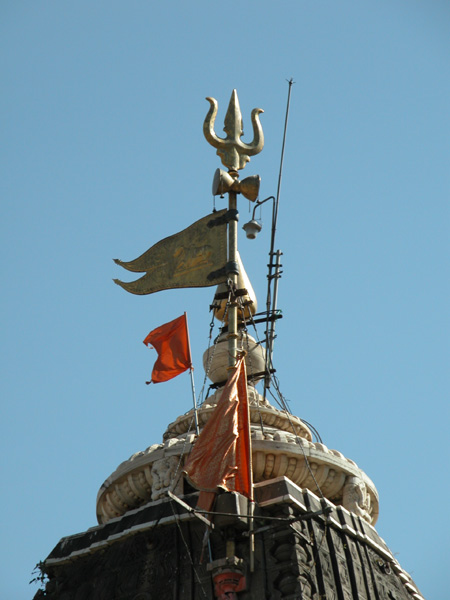 |
The Triyambakeswara Jyotir Lingam Temple, Nasik, Maharastra |
|
 |
The Triyambakeswara Jyotir Lingam Temple, Nasik, Maharastra |
|
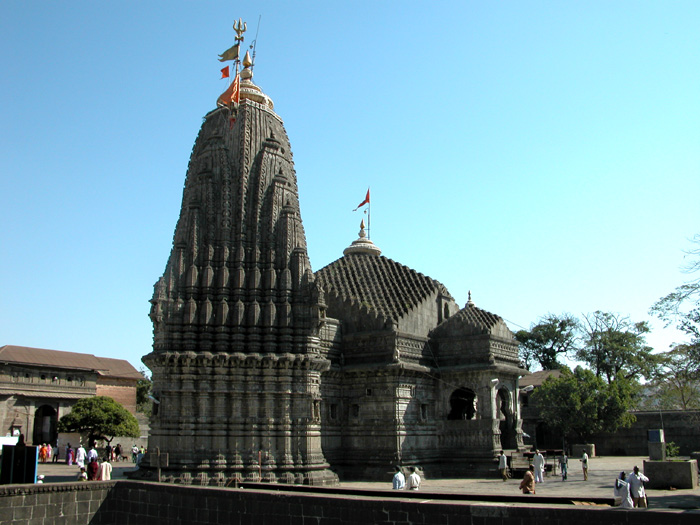
|
The Triambakeswara Temple |
|
Trimbak,
33 km vest of Nasik in Maharashtra is revered as the city of one of the 12
Jyotirlinga shrines of Shiva. It is here in the Anjaneya
Mountains that the
river Godavari originates. From a spring high on the steep Brahmagiri hill above
Trimbak, the Godavari River dribbles into the Gangadwar bathingtank, whose
waters are reputed to wash away sins. From this tiny start the Godavari flows
right across India, down and out in the Bay of Bengal. The Godavari River is
called Ganga in these parts of the country.
* The four Jyotir lingams of Maharastra is:
Mahakaleswar,
Ghusmeswara, Bhimashankar and Triyambakeswar. |
|
Text is under editing - sorry for any inconvinience! |
|
The Triyambakeswara Jyotir Lingam |
|
|
|
The Triyambakeswara Jyotir Lingam is atypical, as it is divided in three smaal thumb shaped Lingams placed at the edge of the hole in the Yoni. The hole is apr. 20 cm in diameter and often filled with offerings like milch, flowers, Bilva leaves aso. |
|
|
|
Mythology |
|
Legend has it that sage Gowtama resided on the Brahmagiri hill here with his
wife Ahalya, and seeing his unflinching devotion received a boon from Varuna - a
bottomless pit from which he received an inexhaustible supply of foodgrains.
This of course enraged other sages who conspired for a cow to enter his granary,
and caused it to die as Gowtama attempted to ward it off with a bunch of Darbha
grass. Because of this misfortune Gowtama therefore worshipped Shiva, to invoke
the Goddess Ganga down to his hermitage to purify the premises. Ganga came down
as Godavari, and Shiva took up an abode here in the form of Tryambaka.
Interestingly, locals refer to the river here as Ganga and not as Godavari. Legend has it that Brahma and Vishnu searched in vain to discover the origin of Shiva who manifested himself as a cosmic column of fire. Brahma lied that he had seen the top of the column of fire, and was hence cursed that he would not be worshipped on earth. In turn Brahma cursed Shiva that he would be pushed underground. Accordingly, Shiva came down under the Brahmagiri hill in the form of Tryambakeshwar. The shrine enjoyed the patronage of the Peshwas. |
|
A walk in the temple premises ... |
|
|
|
|
|
The Temple |
|
The Nagara style of architecture is what typifies this temple made of black
stone. It is enclosed in a spacious courtyard and the sanctum (internally a
square and externally a stellar structure) houses a small Shivalingam -
Tryambaka. The sanctum is crowned with a graceful tower, a giant amalaka and a
golden kalasha. In front of the garbagriha and the antarala is a mandap with doors on all four sides. Three out of the four doorways are covered with porches, and the openings of these porches are ornamented with pillars and arches. The roof of the mandapam is formed by curvilinear slabs rising in steps. The entire structure is ornamented with sculptural work featuring running scrolls, floral designs with a big turtle in the middle, figures of gods, yakshas, humans and animals. The Shivalingam is seen in a depression on the floor of the sanctum with water constantly oozing out from the top of the Shivalingam. Usually, the Shivalingam is covered with a silver mask, and on festive occasions with a golden mask with five faces, each with a golden crown. The silver mask is equivalent to the processional images seen in South Indian temples. |
|
|
|
|
|
|
|
|
|
|
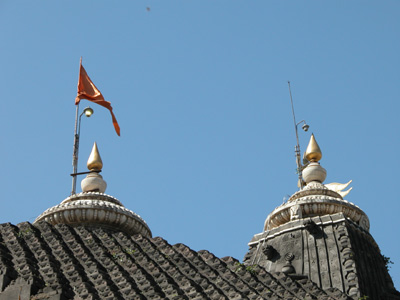
The front and main temple towers

Watching the temple tower will give you enlightenment

A serene and prayerfull atmosphere ...
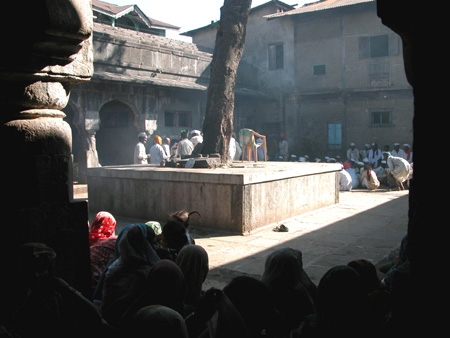
... in the temple yard
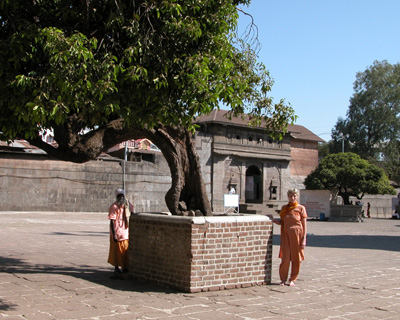
Large bonsai-like trees in the temple yard
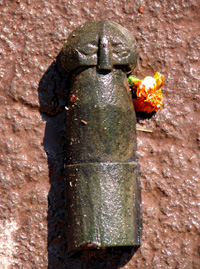
Fertility symbol
found on the ground
|
The Kusha Water Pond |
|
|
| Pilgrims and families at the
Kusha Varta pond.
The pond is believed to be one of the three places where the river Godavari
takes birth. It is ordained to take bath in this pond before the Darshan of the Trayambakeshwara Shiva Lingam. |
|
|
|
The Maha Vishnu shrine |
|
|
|
|
|
|
|
Lord Dattatreya is also worshipped in these areas |
|
|
OM Namah Shivaya!
mukti4u2.dk ► created by BP